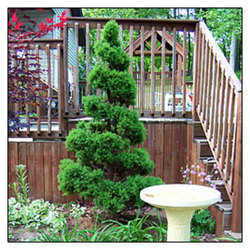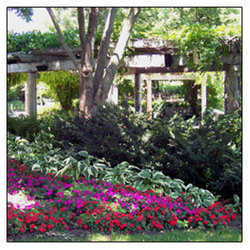This artful pruning skill is, by no means, modern; several sources cite the Persian Empire and Ancient Egypt as perhaps the origin of the art. Roman Consul Pliny the Elder (AD 62-110) described elaborate animals, geometric, and whimsical shapes in the garden of his Tuscan villa. Most experts on the art agree that the Romans introduced topiary into Great Britain, one of the treasure troves of fantastic sculpted gardens. After the Romans departed, topiary was largely confined to monastery gardens.

In the Far East, topiary is practiced somewhat differently, with the focus being on the natural forms created by wind and weather. Japanese bonsai (literal meaning: tree in a pot) is an excellent illustration of this style. Chinese penjing is the creation of miniature landscapes in a tray, usually with one central "tree" or "shrub." Japanese "cloud-pruning" more closely resembles the familiar structured approach of topiary in the outdoor landscape.
Traditional topiary shapes included cubes, balls, pyramids, cones, obelisks, and other similar shapes, with the occasional animal or bird as conversational pieces. The art form spread around the world, with each "artist" striving to design and perfect the "next big thing." Sixteenth century gardener Andre le Notre designed huge elaborate hedges for the Palace of Versailles outside Paris and, soon, this "Versaill es style" became all the rage in Denmark, Germany, Russia, and Sweden. The Dutch took the design concept one step further, adding individual specimens as points of interest. After the Norman conquest, mazes and labyrinths were very popular, but topiary commanded the formal landscape in the seventeenth century.
es style" became all the rage in Denmark, Germany, Russia, and Sweden. The Dutch took the design concept one step further, adding individual specimens as points of interest. After the Norman conquest, mazes and labyrinths were very popular, but topiary commanded the formal landscape in the seventeenth century.
English topiary declined in popularity amongst the aristocrats in the eighteenth century, but still flourished in cottage gardens on a smaller scale. Though the art was seldom found in early American gardens, the American Renaissance (1880-192 0) led to more interest in the style and, as a result, the topiary maze at the Governor's Palace in Colonial Williamsburg was replanted in the 1930's.
0) led to more interest in the style and, as a result, the topiary maze at the Governor's Palace in Colonial Williamsburg was replanted in the 1930's.
Topiary today is as whimsical and charming as in ages past. From the formal "gates," "grottoes," "porticos," and "rooms" to fantastical donkeys, eagles, boats, bears, steam trains, and even racing cars, topiary continues to work its ancient charm on all who view it.
(Editor's Note: This article was originally published on January 18, 2008. Your comments are welcome, but please be aware that authors of previously published articles may not be able to promptly respond to new questions or comments.)

















